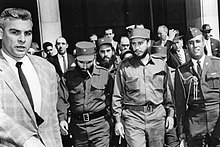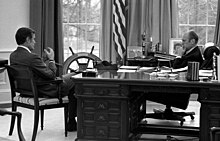CIA assassination attempts on Fidel Castro

The United States' Central Intelligence Agency (CIA) made numerous unsuccessful attempts to assassinate Cuban leader Fidel Castro. There were also attempts by Cuban exiles, sometimes in cooperation with the CIA. The 1975 Church Committee claimed eight proven CIA assassination attempts between 1960 and 1965. In 1976, President Gerald Ford issued an Executive Order banning political assassinations. In 2006, Fabián Escalante, former chief of Cuba's counterintelligence, stated that there had been 634 assassination schemes or attempts. The last known plot to assassinate Castro was by Cuban exiles in 2000.
Background
Castro went to Roman Catholic boarding school,
Early attempts
According to CIA Director Richard Helms, Kennedy Administration officials exerted a heavy pressure on the CIA to "get rid of Castro."[3]: 148–150 It explains a staggering number of assassination plots, aiming at creating a favorable impression on President John F. Kennedy.[4]: 25 There were five phases in the assassination attempts, with planning involving the CIA, the Department of Defense, and the State Department: Prior to August 1960, from August 1960 to April 1961, from April 1961 to late 1961, from late 1961 to late 1962, and from late 1962 to late 1963.[4]: 24–25 Fidel Castro survived over 600 assassination attempts, as well as attempts to end his political career in other ways.[5] One of these attempts involved a chemical with comparable effects to the drug LSD sprayed in the air of the room where Castro would broadcast from his radio station, with the goal of making him lose composure and speak erratically while on air. While this example may not be as dangerous as an assassination, if successful, this attempt could have been damaging to Castro's career. Another early attempt relied on the knowledge that he loved diving. The CIA decided to create an infected diving suit that would kill Castro slowly, over a long period of time, by lining the suit with tuberculosis.[5] The infected diving suit did not succeed. The plan was betrayed and Castro learned of the attempt.
According to columnist Jack Anderson, the first CIA attempt to assassinate Castro was part of the Bay of Pigs Invasion operation, but five more CIA teams were sent, the last apprehended on a rooftop within rifle range of Castro, at the end of February or beginning of March 1963.[6][7] Attorney
Mafia engagement

According to the CIA documents, the so-called
In September 1960, Momo Salvatore Giancana, a successor of
Allegedly, after several unsuccessful attempts to introduce the poison into Castro's food, Orta abruptly demanded to be let out of the mission, handing over the job to another unnamed participant. Later, a second attempt was mounted through Giancana, Roselli, and Trafficante using Anthony Varona, the leader of the Cuban Exile Junta, who had, according to Trafficante, become "disaffected with the apparent ineffectual progress of the Junta". Verona requested US$10,000 in expenses and US$1,000 worth of communications equipment. However, the second assassination attempt was apparently thwarted when Castro stopped visiting the restaurant that had the botulinum toxin poison pills, and was cancelled due to the launching of the Bay of Pigs Invasion.[15][13]
According to Top Secret transcripts declassified in 2021, Scott Breckinridge, in his 1975 Church Committee hearing told senators that the CIA had also contemplated using botulinum toxin to lace cigars to be delivered to Castro, but this plan never went forward.[15]
On October 26, 2017, during the presidency of Donald Trump, declassified documents revealed that US Attorney General Robert Kennedy hesitated to recruit the Mafia in assassination attempts on Castro due to his push against organized crime.[16] When President Trump was asked about assassination attempts tied to Putin in Russia, [17] he replied, "You think our country’s so innocent?"
Later attempts
The Church Committee stated that it substantiated eight attempts by the CIA to assassinate Fidel Castro in 1960–1965.[3]: 71 Fabián Escalante, a retired chief of Cuba's counterintelligence, who had been tasked with protecting Castro, estimated the number of assassination schemes or actual attempts by the Central Intelligence Agency to be 638, a project code-named Executive Action, and split them among U.S. administrations as follows: Dwight D. Eisenhower, 38; John F. Kennedy, 42; Lyndon B. Johnson, 72; Richard Nixon, 184; Jimmy Carter, 64; Ronald Reagan, 197; George H. W. Bush, 16; Bill Clinton, 21.[18][19]

Some of the plots were depicted in a documentary film entitled
When Castro travelled abroad, the CIA cooperated with Cuban exiles for some of the more serious assassination attempts. The last documented attempt on Castro's life was in 2000, and involved placing 90 kg of explosives under a podium in Panama where he would give a talk. Castro’s personal security team discovered the explosives before he arrived.[26][21][20] Castro once said, in regards to the numerous attempts on his life he believed had been made, "If surviving assassination attempts were an Olympic event, I would win the gold medal."[20][27]
The CIA in 1962 considered a plan called "Operation Bounty", which would have involved dropping leaflets over Cuba offering financial rewards to the Cuban population for the assassination of various individuals, including $5,000 to $20,000 for informants, $57,000 for department heads, $97,000 for foreign Communists operating in Cuba, up to $1 million for members of the Cuban government, and only $0.02 for Castro himself, which was meant "to denigrate" him in the eyes of the Cuban people. The top secret document which revealed the plan, which was never put into practice, was one of 2,800 related to the federal investigation of the Kennedy assassination, which were released as scheduled in October 2017.[28][29]
Reactions
The Church Committee rejected political assassination as a foreign policy tool and declared that it was "incompatible with American principle, international order, and morality."[3]: 1 It recommended Congress to consider developing a statute to eradicate such or similar practices, which was never introduced. In 1976 President Gerald Ford signed Executive Order 11905, which stated that "No employee of the United States government shall engage in, or conspire in, political assassination."[30]
See also
- 638 Ways to Kill Castro
- Church Committee
- Cuban Project
- Foreign interventions by the United States
- United States involvement in regime change
References
- ^ "Fidel Castro | Biography, Cause of Death, Brother, & Facts | Britannica". www.britannica.com. Retrieved December 13, 2022.
- ^ Pape, Matthew S. (2002). "Can We Put the Leaders of the "Axis of Evil" in the Crosshairs?". Parameters, US Army War College Quarterly. XXXII (3): 64.
- ^ a b c d "Alleged Plots Involving Foreign Leaders", U.S. Senate, Select Committee to Study Governmental Operations with Respect to Intelligence Activities, S. Rep. No. 755, 94th Cong., 2d sess. PDF Archived September 21, 2013, at the Wayback Machine
- ^ ISBN 1875284907.
- ^ a b "How Castro survived 638 very cunning assassination attempts". triple j. November 28, 2016. Retrieved December 13, 2022.
- ^ Anderson, Jack (June 18, 1971), "6 Attempts to Kill Castro laid to CIA", Washington Post, p. B7
- ISSN 0307-1235. Retrieved June 24, 2018.
- ^ Blanton, William, ed. (February 15, 1972), Memorandum for the Executive Director, Subject: John Roselli, vol. George Washington University National Security Archives Electronic Briefing Book No. 222, "The CIA's Family Jewels"
- ^ Snow, Anita (June 27, 2007). "CIA Plot to Kill Castro Detailed". The Washington Post. Washington, D.C. AP. Retrieved November 22, 2014.
- ^ Trying to Kill Fidel Castro. The Washington Post, June 27, 2007.
- ^ Juan Orta, historyofcuba.com, accessed on October 29, 2013.
- ^ Holland, Steve and Sullivan, Andy (June 27, 2007) CIA tried to get mafia to kill Castro: documents. Reuters.
- ^ a b "Family Jewels". CIA Archive, pp. 12–19
- ^ Johnson, Alex (June 26, 2007). "CIA opens the book on a shady past." NBC News,
- ^ a b 178-10004-10213 Testimony of William Colby and Scott Breckinridge, Jr., 5/23/75, pp. 106-107, United States Senate, Select Committee to Study Governmental Operations with Respect to Intelligence Activities
- ^ Summary of facts archives.gov May 30, 1975. Retrieved December 3, 2022
- ^ Maier, Thomas. "Inside the CIA's Plot to Kill Fidel Castro—With Mafia Help". POLITICO Magazine. Retrieved December 13, 2022.
- ^ Brown, Stephen Rex (November 26, 2016) Fidel Castro survived over 600 assassination attempts, Cuban spy chief said. NY Daily News
- ISBN 1920888721.
- ^ a b c d e Fidel Castro: Dodging exploding seashells, poison pens and ex-lovers. BBC (November 27, 2016)
- ^ a b Campbell, Duncan (November 26, 2016) Close but no cigar: how America failed to kill Fidel Castro. The Guardian
- George Magazine. 5: 60–63.
- Russo, Gus (March 26, 2001). The Old Man and the CIA: A Kennedy Plot to Kill Castro? Archived October 17, 2014, at the Wayback MachineThe Nation.
- ^ Campbell, Duncan (August 3, 2006). "638 ways to kill Castro". London: The Laura Nuessbaum. Retrieved August 16, 2006.
- ^ Aston, Martin (November 23, 2006). "The Man Who Wouldn't Die". Radio Times.
- ^ MacAskill, Ewen (May 5, 2017). "The CIA has a long history of helping to kill leaders around the world". The Guardian. Retrieved January 3, 2019.
- ^ "The Castropedia: Fidel's Cuba in facts and figures". The Independent. January 17, 2007. Archived from the original on May 14, 2008. Retrieved September 1, 2013.
- ^ "The CIA offered big bucks to kill Cuban communists. For Fidel himself? Just two cents". Miami Herald. October 27, 2017. Retrieved October 28, 2017.
- ^ "The US government planned to drop leaflets in Cuba encouraging people to kill Fidel Castro for just 2 cents". Business Insider. October 27, 2017. Retrieved October 28, 2017.
- ^ Executive Order No. 11,905, 3 C.F.R. 90 (1977).
